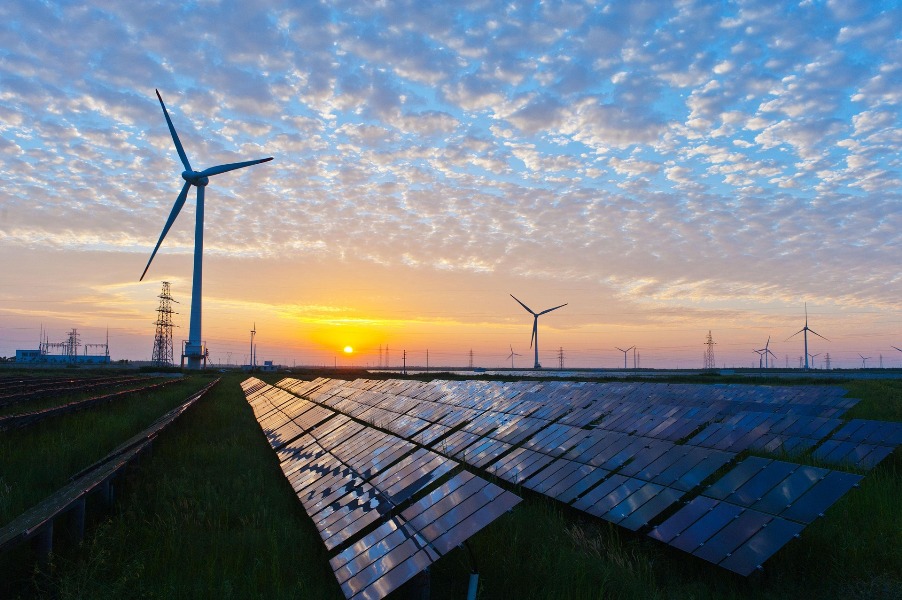The wind-solar plant will be recognized as a hybrid plant if the rated power capacity of one resource is at least 25 per cent of the rated power capacity of another resource. In the AC integration, both the wind and solar systems integrated to the step-up transformer and HT output of both the systems are connected to the common AC busbar.
The peak operating time for wind and solar systems occur at different times of the day and year.
The wind and solar potential rich sites near PGCIL substations are targeted to create techno commercially optimal solutions of the hybrid system design. The various combination of wind solar hybrid system design provides the capacity utilization factor (CUF) in the range of 35 per cent to 48 per cent depending on the solar heavy configuration or the wind heavy configuration of the project in different parts of the country.
The peak operating time for wind and solar systems occur at different times of the day and year. When wind speed is low in summer at that time solar radiation is brightest and longest. In monsoon months, winds are strong whereas less sunlight is available owing to cloud cover. This simultaneous nature of generation helps to create wind solar hybrids as cost-effective energy solutions in the country.
The biggest beneficiary states for wind solar hybrid plants are Gujarat, Rajasthan, Karnataka, and Madhya Pradesh.
Finding the optimum solution is a very complex exercise and one needs to understand the potential of both resources – wind and solar. This means an ideal location should have good irradiation and also experience high wind speeds. Evacuation infrastructure facilities should also be available in the neighbourhood of the potential area.
The biggest beneficiary states for wind solar hybrid plants are Gujarat, Rajasthan, Karnataka, and Madhya Pradesh. Some other low potential areas may also expect some transactions in the state like Andhra Pradesh, Tamil Nadu and Maharashtra. The feasibility of the hybrid project is also depending upon the land, permits and approval process of the state.
To achieve competitive pricing and cross-subsidising costlier wind power with low cost solar power, many key considerations are needed for planning of hybrid system design.
Wind is highly variable and complex by nature as compared to solar.
A cost-effective design is a priority for planning a wind solar hybrid power system. The various aspects that are optimally adjusted before commencing are size, fluctuation of load and energy generation estimation. But, some design considerations such as wind solar hybrid ratio, DC side overloading in solar, annual degradation of PV panel and technology selection of solar and wind are also important.
Besides the priority objective, when the reliability of supply is observed, the optimum number of units plays an important role. Graphical construction and probabilistic approaches in combination with an optimization method are used for planning the hybrid power plant.
The resource variability and pattern forecast from sun and wind is complex; specifically, wind is highly variable and complex by nature as compared to solar. The variable attribute of climatic fluctuations is the reason of inconsistency of the wind-solar hybrid resources and creates uncertainty in the energy production in the range of seconds, hours, days and years even. The yearly wind variability in the country is in the range of 3-6 per cent which is equivalent to the 5-10 per cent in terms of yearly energy variation at different sites and technology. The solar irradiation is more stable and focus should be on the long-term hourly time series data instead of typical meteorological yearly average data. The peak hour of energy specifically during 11 am to 4 pm in wind solar hybrid system design needs to be reviewed with extra care specifically in high windy months.
The electrical infrastructure like location of pooling substation, grid sub-station and internal transmission line plays a key role in the optimization of hybrid plants.
The electrical infrastructure like location of pooling substation, grid sub-station and internal transmission line plays a key role in the optimization of hybrid plants. The substations connected to the interstate transmission system (ISTS) network are preferred as compared to the state substation mainly due to high grid availability. The quality of pooling substation, internal line/ feeder and appropriate maintenance planning are key factors in the operational phase to better utilization of co-located hybrid plants.
The power generation forecast for hybrid plants is interesting to see in the future. There are many numerical weather prediction models and statistical tools that are available to predict the hybrid power plant output. To predict the wind power with a 15-minute time block interval is a complex task as compared to solar and when it comes to hybrid it’s interesting to see the accuracy part of hybrid power forecast.
The hybrid power plant along with the energy storage system further improves the capacity utilization factor (CUF) and creates many feasible options of peak power and round the clock power output.
Optimizing the right hybrid curve in the energy mix gives viable new renewable energy options in India. It could also emerge as a saviour for India’s wind sector and at the same time create power in peak hours and better energy mix into the grid. The wind solar hybrid market will grow very fast and an under-construction project soon creates the operational history and dispatchable energy in the country.
About the author: Keyur Vora is General Manager Technical, Amp Energy India

